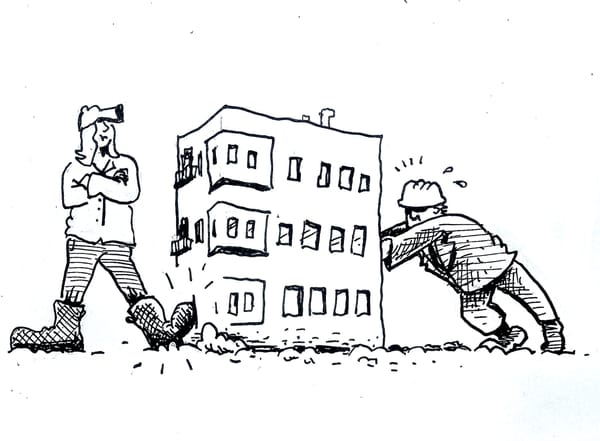Governor Scott's Public Safety Bill Prioritizes Carceral Policies
The administration's new proposal aims to retrofit prison facilities for use in crisis care and treatment

At his press conference on Wednesday, February 12th, Governor Scott laid out the tenets of his public safety omnibus bill, with help from Public Safety Commissioner Jennifer Morrison and Human Services Secretary Jenny Samuelson.
According to Scott, the ultimate goal of the bill is to "hold those who continue to commit crimes and disrupt our quality of lives accountable." Accountability was definitely top of mind for Scott during the conference, his response to what has been deemed "a revolving door" in the justice system for criminal offenders, who are often apprehended by police, released on conditions, and then picked up again for the same behaviors before ever seeing a court date. This is due in large part to backlogs in the court system stemming from chronic vacancies in the judiciary.
The governor's bill, which has already been shared in part with the House and Senate Judiciary Committees, contains 10 main policy buckets.
Commissioner Morrison described the need for changes in Vermont's public safety policy as "a pendulum that has swung too far and needs to be rebalanced" and outlined the policies as such: 1.) repealing the law that raises the "youthful" offender status to 19; 2.) upping accountability and rigor for youthful offenders who refuse to engage with rehabilitation or services; 3.) reforming bail revocation to address repeat offenders; 4.) universal sealing of criminal records instead of expungements; 5.) limiting court discretion to reduce or suspend sentences of repeat violent offenders; 6.) streamlining the process of extraditing offenders wanted on out-of-state warrants; 7.) redefining recidivism; 8.) expanding a pilot program of pre-trial supervision currently used in Orleans County; 9.) increasing substance abuse and mental health care tools;* and 10.) reinstating the detox provision,** which is currently set to expire July 1st.
*I found the specifics here a little unclear. Morrison phrased it as "expand[ing] the suite of tools to connect people to the correct level of care." Language was also used about "filling gaps in the system."
**The detox provision allows correctional facilities to hold non-compliant intoxicated individuals who have not committed a crime under custodial care.
When Jenny Samuelson, Health and Human Services Secretary, took to the podium, she mostly congratulated her own agency for, in her words, "strengthening our mental health and substance use systems here in Vermont" and "taking crucial steps towards fostering healthier individuals and building safer, more resilient communities." According to Samuelson, the successes of her agency over the last few yeas include the implementation of the 988 crisis helpline, the establishment of mobile crisis teams, bringing clinicians into law enforcement agencies, and making enhancements in involuntary mental health care.
Samuelson also added some details about the omnibus bill's "tools" for increasing access to addiction treatment and mental health care. If I'm understanding correctly, this involves requisitioning prison facilities to create a residential care program for those experiencing mental health and addiction crises. According to Morrison, this is an opportunity for efficiency, given that 70% of incarcerated Vermonters are already receiving treatment for addiction. The governance policy of this prison-turned-residential-facility was not expanded upon. It also wasn't clear to me whether users of the beds would be voluntary residents, involuntary patients held in custodial care, or legally incarcerated.
The price tag of this program was briefly mentioned: 1.5 million dollars.
I can't help but feel that Scott threw this number out expecting it to be received gratefully by those who want him to spend more on social programs. But none of his team ever circled back to the long-term costs of the program or how these costs compare to other strategies, such as expanding community-based organizations, which he claims Vermont can't afford.
And through the entire press conference, there was no acknowledgement of the administration's struggles in tackling these issues for the last eight years, no retrospectives on what they've learned.
No—for the lack of a better word—accountability.
Before I continue with my analysis of the public safety policy roll out, I want to make one thing clear.
I unequivocally support victims of violent crime being safe from their victimizers. I support the state of Vermont having reliable and effective systems in place so that vulnerable people can be certain that those who continually perpetuate harm are prevented from doing so. I support the state taking steps to address the impact of violent crime on our communities. The critique in this article lies mainly in the fact that Scott's policy rollout focuses entirely on the expansion of police and prison-based solutions, while giving no airspace to the systemic issues in healthcare and judiciary that are fundamentally involved.
When the administration makes clear where their priorities lie, I think it's wise to investigate what those priorities are and what they might mean for the future of our state.
One thing really stood out to me while watching the press conference.
Throughout both Morrison and Samuelson's speeches, much of the verbiage circled around the concept of population hygiene. Ideas about building "healthier communities" and helping Vermonters experiencing substance abuse to find "healing." Jenny Samuelson, Secretary of the Agency of Human Services, ended her segment with the statement, "Healthy people make healthy and safe communities."
This feels like crafted language. Healing is generally a good thing; it's meant to appeal to our positive sensibilities. But using that language to cushion a policy rollout that explicitly supports reversing rights for young offenders, reinstating involuntary detainment of intoxicated individuals by correctional facilities, and requisitioning beds in Vermont's prisons for use by residents experiencing acute crises underlines the ghoulish attitude that has characterized so much of the administration's approach to social services and public health.
Time and time again, when Scott's administration has been tasked with providing basic services for Vermont's most vulnerable residents, they've engaged in blame-shifting and stalling.
Finding beds for those experiencing crisis—whether that crisis be housing, addiction, or mental health-based—has continuously been framed as an insurmountable task, beyond the scope of Vermont's infrastructure or social economy. When forced to provide emergency services via wildly expensive out-of-state contractors (due to the administration's failure to develop sustainable alternatives), the governor points to the price tag as a reason why such services are untenable in the first place.
It's hard not to see this circular logic of failure as an intentional effort to move Vermont's social safety net policies as far to the right as possible. After the Vermont GOP victories in November, Scott is using the Republican turnout as a "mandate" for his conservative social policies. But it seems very likely that at least some of that turnout was motivated by a response to the crises that Scott himself has failed to solve for the last eight years.
This isn't the time to double down on a carceral approach to social problems.
At a moment when the president is making baldly eugenicist statements about eliminating disabled people from public life, we need to know that Vermont's government is centering a human-first approach to mental health care and addiction. Instead, we have the executive branch advocating for their public safety policies with language that all feels a little bit more like....well, this.
This is nothing new from Scott's playbook. He continuously batted away questions with his signature smug befuddlement, repeating the word "accountability" at every possible opportunity. He failed to point to any data which would support his affordability argument. He neither offered nor was asked to provide proof that allowing the state to fall back on carceral policies would ultimately cost less than expanding the judiciary or investing in more community-based social services. Who needs data, when we have weary assurances from the governor that his policy makes sense; it's what's right.
"[Vermonters] don't feel safe anywhere," he assured the public.
The statement went unchallenged.
I think the weakness and ultimate fallibility of Scott's governance was exemplified by a response he gave to an all-too-related question during the press conference.
Scott was asked what contingency plans the state has developed should Blue Cross Blue Shield of Vermont fail. BCBSVT provides health insurance for 1/3 of all Vermonters and is currently undergoing a financial crisis.
After some pressure, Scott admitted there's no contingency plan. "I don't want to deal with the what-ifs until it actually happens," he said. From a governor who's spent most of his tenure kicking problems down the road, that sounds about right.
But I can't help but wonder: has this manufactured necessity for regressive policies been the plan all along?




